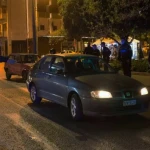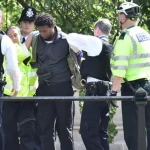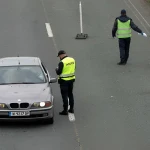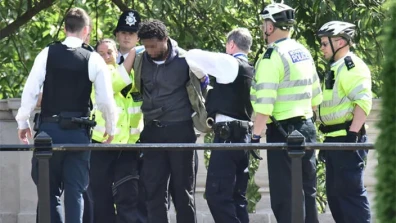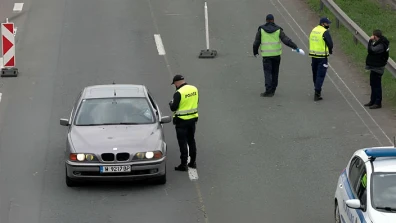Do you know how to tell if a baby bird is dying? If your answer is ‘no’, we have some information here to share with you that may help you to know if a baby bird is dying or is in a withering condition that may eventually lead to their death.
We are going to share some symptoms that clearly indicate whether a baby bird is going to die.
We also have some tips to share with you that may help you recover baby birds from their appalling condition and eventually save their lives.
Table of Contents
Vulnerable Conditions
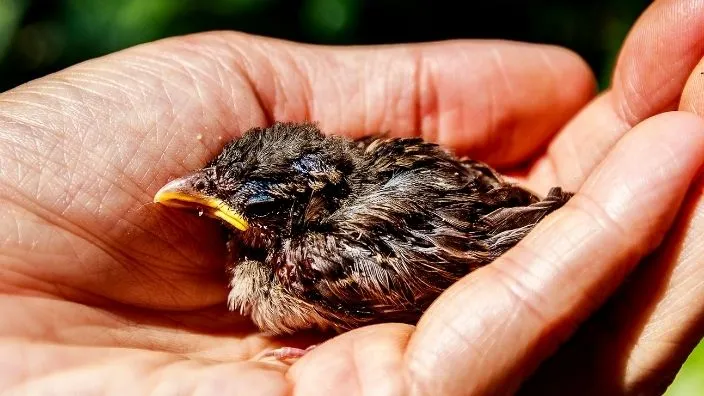
All you have to do is to assume the age of the baby bird by observing whether it is a Nestling or a Fledgling, identify the physical symptoms of a dying baby bird, take the necessary precautions before helping it and follow some instructions that are all about ‘how to save a dying baby bird?’.
Initial Assessment
If you find a baby bird fallen on the ground at your home, or walking along a road or somewhere outside under trees in a forest or in your fields, you can observe the symptoms and signs.
We are going to share with you may help you figure out whether the baby bird is out of danger, or a sick one about to die shortly and save its life, giving the little one a chance to fight a challenging battle.
To know more about the initial assessment of disease, it is suggested to read the article How to Clear Histamine from Body
Baby Bird, a Nestling or a Fledgling?
We have something to share with you in order to identify whether it is a Nestling or a Fledgling, so that you may accordingly take the necessary steps to save the young one.
Nestling vs. Fledgling?
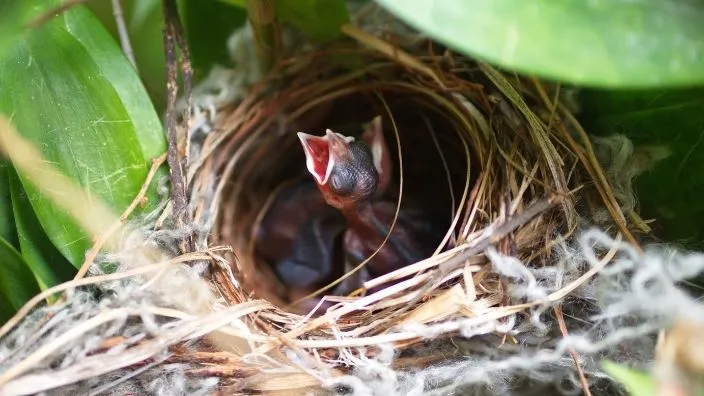
A Nestling is a baby bird which does not have a lot of feathers on its skin except a few, or it may be totally bald and have bare skin. It is too young to take a flight and be able to come out of its nest. It is not even able to balance itself on its feet.
Conversely, a Fledgling is a baby bird that has got a lot of fuzzy and adult feathers grown on its skin. It may have the looks of an adult in terms of its size and feathers. If you come across an old enough bird hopping on the ground and taking short flights, it is a Fledgling for sure.
Considerable Positions
Now, let's move to the core of the topic for which we have gathered numerous factors to share with you so you become aware of the physical conditions of the bird showing a lethargic attitude and likely to have a short life ahead.
Physical injuries
Once you have figured out whether the baby bird is a Nestling or a Fledgling, now, it’s a great time to look for the physical signs and injuries that indicate whether the baby bird is unwell.
If you observe them keenly, you may find some obvious signs of injuries, such as: -
- Notice blood on the injured part of the baby bird, or redness
- You may find some flies around it attracted by the blood.
- It’s eyes may be bloated
- It’s legs and plumages may be broken.
- It’s feathers may be dislodged.
Any of the above-given signs indicate serious injuries to the baby bird and may lead to its death if it is not given proper treatment and care, and is left on their own for a longer time.
Symptoms in the Baby Bird
Having given an account of the injured conditions of a baby bird likely to expire if due care is not afforded to it. Next, we are supposed to share some of the medical symptoms which you can safely notice in the ailing bird.
Breathing pattern
A baby bird needs help to be put back to its nest whether it is a Nestling or a Fledgling. But if you have discovered a Fledgling, you can get a good idea of the condition of the baby bird after observing the physical signs and injuries of the baby bird and may decide whether it is dying.
Check the breathing pattern of the baby bird and figure out whether it has some problems in its respiratory system. This issue is as natural to baby birds as it is to humans. Here are some signs that indicate whether the baby bird is struggling with breathing: -
- Its breathing may be faster than normal pattern.
- It may produce wheezing sounds
- It may be panting heavily
- It’s nape may be moving to pass in the air.
If it’s not enough for you to tell if the baby bird is dying, you may look for some other indications in the baby bird to check the condition of its health.
Changes in feathers
After observing the breathing patterns of the baby bird, you can look for the condition of its feathers if it is a Fledgling and may notice some signs indicating if the baby bird is near death. The indications are: -
- If its feathers are shivering, it indicates the baby bird has a high fever.
- If there is scantiness of feathers on its body, go for observing its skin.
- If its skin is dry, there is a high possibility of it being infected by parasites. Its feathers may look dull, losing their vibrant colours.
- There may be dirt on its feathers which is a sign of it’s hitting the ground after falling from its nest.
- The baby bird may show piloerection even in warm weather and its feathers may look erected.
Discharges
You can notice some discharges around the ears, eyes and nostrils of the baby bird and these areas may seem inflamed, swollen or discolored. Sneezing is possible during the production of discharges.
In order to identify the hardship of illness the bird is facing you can consider the dull eyes, changes in the voice, dropping, wastes and visible injury, if any.
Whether baby bird lethargic
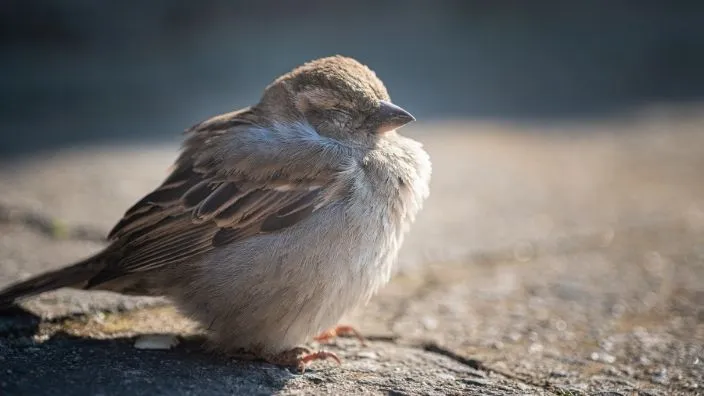
You must have noticed that a healthy baby bird is quite active, and hops energetically if it is a Fledgling. If you notice the baby bird lacking all this, it may be an indication of the sickness of the baby bird.
Notice its Vocalization
Sharp chirps of the baby bird are common whether it is a Nestling or a fledgling. If you notice silence or change in the vocalization of the baby bird that is not normal, it is also a sign of bad health.
Loss of Appetite
It can be noticed in dying baby birds that it doesn’t show a need to eat and seems out of energy. It indicates that the baby bird is soon to die.
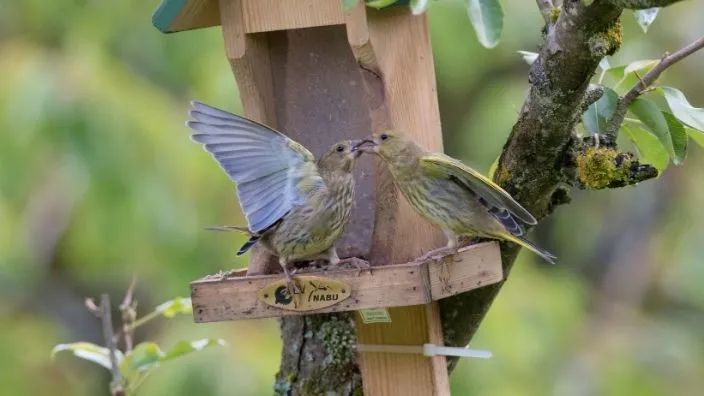
After observing all these symptoms, you can think of trying to save it with the maximum care and protection you can give it.
Helping a wounded or sick baby bird could be a bit tricky and you need to know some necessary precautions and some instructions as well If you really want to save the life of the little one.
You may overdose it or not provide it with the proper temperature and environment they need. Here, we have got some necessary precautions to be taken and some instructions to be followed to help you save a dying baby bird: -
Is baby bird got hurt?
It’s important to figure out if the baby bird has got some injuries or caught fever. Find the indications of injuries or sickness in the baby bird which we have already mentioned above.
Thereafter find below the helping plans to accommodate and save them from dying.
How to help a Nestling?
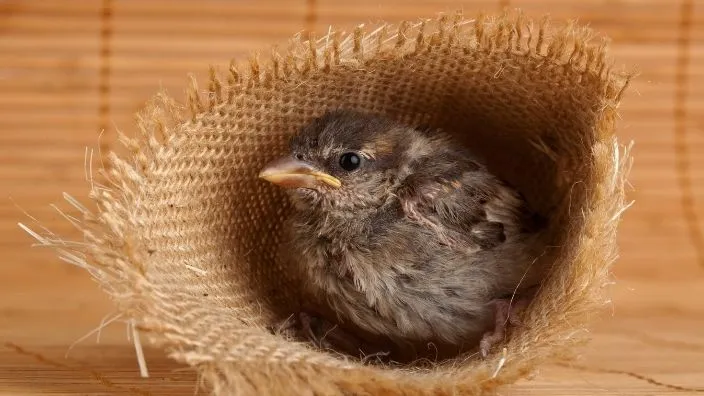
- If you have found it under a tree, look for the nest in that very tree and put it back there.
- If you have found it in your house, look for its nest somewhere in ventilators or roofs of the rooms.
- If you do not find any nest nearby, Contact some wildlife rehabilitator, or make a warm nest for baby bird.
- Take a small basket or a plastic container and make small holes punched for proper ventilation.
- You should cover the box with something so that the baby bird does not get out of it.
- Try to keep the baby bird warm and don’t expose it to a lower temperature.
- Keep the box out of the reach of children so that they are unable to tease the baby bird else children.
- Make it sure that the box is out of the range of your pets, like cats and dogs.
- Drink the baby bird water with a syringe if it is an untrained one, and when it is able enough to eat.
- If you have an injured baby bird and are not sure how to help it, contact some wildlife rehabilitator.
How to help a Fledgling?
A Fledgling usually tries to make attempts to fly and sits often on the edge of the nest. When trying to fly, it may not take a successful flight and fall on the ground and may get hurt.
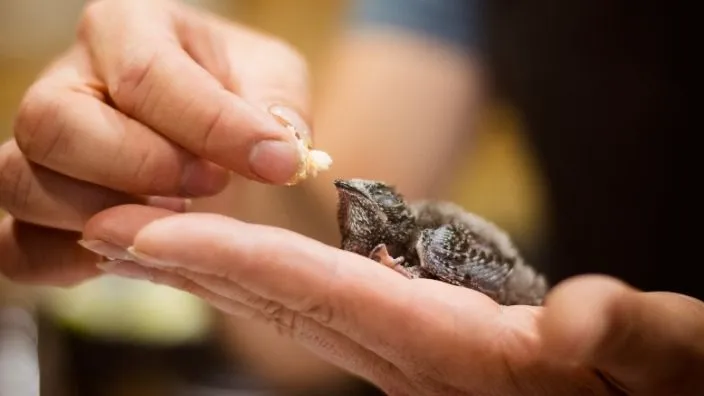
In order to help it, you can follow some instructions we have got for you here: -
- If you have found a Fledgling under some tree outside, look for the signs of injuries aforementioned on its body.
- If it is unhurt, leave it alone, there is no need to help it for the time being.
- If you have found it in your house somewhere, it is possible that the baby bird has lost its parents because pets, like dogs and cats, may remove it to another location. Now, in order to save the baby bird: -
- Make it sure pets do not happen to catch it.
- Make it also sure to keep the baby bird away from children.
- Make a conformable nest for it and keep it out of the reach of pets.
- Once you have removed such possible dangers, try to arrange food for the baby bird as parents feed their fledglings for two or three weeks even though they have learnt to fly.
- Let the baby bird practice flying after a couple of days so that it may be able to escape predators.
- If you are unable to remove the dangers and make a safe nest for the baby bird, call a rehabilitator.
Conclusion
In this article, we have explained how to identify young birds or younger birds sick or wounded fledgling, sick birds, the birds dies like other birds need safe and warm location for their survival in the life.
Injured birds or wounded fledgling being natural habitat can be sent to wildlife agency for heating pad beneath.
However, one can easily identify labored breathing, air holes or results of improper feeding showing the dying bird with respiratory distress or apparent body temperature, relief with hot water, or other natural causes, which could indicate to sure sign of having deep disease and need for the safe place.
Frequently Asked Questions
Yes, you can tell if the baby bird is close to death if you find in it some indications, such as injuries, lethargy, difficulty breathing, lack of energy, changes in its vocalization, loss of appetite etc.
How do you know if a bird is about to die?
You can tell if the baby bird is close to death if you find in it some indications, such as injuries, lethargy, difficulty breathing, lack of energy, changes in its vocalization, loss of appetite etc.
To save a dying baby bird, you have to identify whether it is a Nestling or fledgling, make sure the baby bird has got hurt and then, take necessary measures accordingly.
You may find symptoms of injuries and illness in the feathers, limbs, skin, nostrils and eyes. You may also observe abnormality in its' activeness, movement, and sound to tell whether it is dying.



